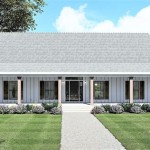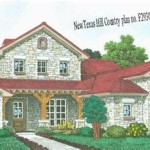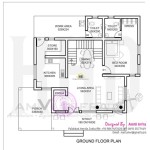House Floor Plans With Butlers Pantry: A Study in Function and Elegance
The inclusion of a butler's pantry in a house floor plan indicates a commitment to both functional efficiency and a certain level of refined living. These spaces, historically designed to support formal dining and household management, are experiencing a resurgence in popularity, adapting to modern lifestyles while retaining their core purpose of streamlining kitchen activities and providing dedicated storage.
Modern butler's pantries go beyond their historical role as purely servicing spaces. They are integrated into the overall flow of the house, acting as a bridge between the kitchen, dining room, and potentially other living areas. This integration requires careful consideration of the floor plan, ensuring that the butler's pantry enhances, rather than disrupts, the home's functionality and aesthetic appeal.
A well-designed butler's pantry can significantly impact the overall feel and usability of a home. Before incorporating one into a floor plan, careful planning and consideration of individual needs and lifestyle are essential. This involves evaluating space requirements, storage needs, and the desired functionality of the pantry within the context of the larger house layout.
Key Point 1: The Evolution of the Butler's Pantry
The historical butler's pantry served as a command center for household staff, particularly the butler, who was responsible for managing silver, china, glassware, and sometimes even wine. These pantries were strategically located between the kitchen and dining room, facilitating smooth service during formal meals. Early designs often included locking cabinets for valuable items and specialized storage for serving pieces.
Over time, as societal norms shifted and household staff became less common, the role and design of the butler's pantry evolved. While the fundamental purpose of storage and service remained, the modern butler's pantry now often serves as an extension of the main kitchen, providing additional counter space, appliance storage, and even a secondary prep area. This adaptation allows homeowners to maintain a clean and organized kitchen while still having a dedicated space for more intensive cooking or entertaining tasks.
Contemporary butler's pantries are frequently customized to reflect the specific needs and preferences of the homeowner. This might involve incorporating features such as wine refrigerators, coffee stations, ice makers, or even a small dishwasher specifically for glassware. The level of customization often depends on available space and the homeowner's desired level of functionality.
The location of the butler's pantry within the house floor plan has also adapted. While still typically situated between the kitchen and dining room, modern designs might see the butler's pantry located closer to an outdoor entertaining area or incorporated as part of a larger, open-concept kitchen design. This flexibility allows for a more seamless integration of the pantry into the overall flow of the home.
Key Point 2: Essential Elements of a Butler's Pantry Floor Plan
Designing an effective butler's pantry requires careful consideration of several key elements. These elements contribute to the overall functionality and efficiency of the space, ensuring that it meets the specific needs of the homeowner. The primary elements include storage solutions, countertop space, appliances, and considerations for traffic flow.
Storage is arguably the most critical element of a butler's pantry. The design should maximize storage capacity while ensuring that items are easily accessible. This might involve a combination of shelving, drawers, cabinets, and specialized storage solutions for specific items, such as wine bottles or serving platters. Pull-out shelves and drawers can improve accessibility, while vertical dividers can help organize baking sheets and cutting boards.
Countertop space is essential for food preparation, serving, and staging. The amount of countertop space needed will depend on the intended use of the butler's pantry. If it is to serve as a secondary prep area, ample counter space is necessary. Durable and easy-to-clean countertop materials, such as quartz or granite, are often preferred. It is also important to consider the placement of outlets for appliances and lighting.
Appliance selection depends on the intended functionality of the butler's pantry. Common appliances include wine refrigerators, beverage centers, ice makers, microwave ovens, and even a small dishwasher. The choice of appliances will influence the design of the pantry, including the placement of electrical outlets and plumbing connections. It is also important to consider the size and dimensions of the appliances to ensure they fit seamlessly into the overall design.
Traffic flow is another crucial consideration. The butler's pantry should be designed to allow for easy movement between the kitchen, dining room, and other areas of the house. The layout should avoid creating bottlenecks or obstructing pathways. The placement of entrances and exits should be carefully considered to ensure a smooth and efficient flow of traffic.
Key Point 3: Integrating the Butler's Pantry into the Overall Home Design
The success of a butler's pantry relies not only on its internal functionality but also on how well it integrates into the overall design of the home. This integration involves considering the style and aesthetic of the house, the adjacency to other rooms, and the overall impact on the flow of space. The design should complement the existing architectural features and create a cohesive and harmonious living environment.
The style and aesthetic of the butler's pantry should align with the overall design of the house. Whether the home is traditional, modern, or somewhere in between, the butler's pantry should reflect that style in its finishes, materials, and overall design. This might involve using the same cabinet style and hardware as the kitchen or incorporating similar design elements to create a sense of continuity.
The adjacency of the butler's pantry to other rooms is critical. As mentioned previously, it is typically located between the kitchen and dining room, but its proximity to other areas, such as outdoor entertaining spaces, may also be considered. The layout should facilitate easy access and smooth transitions between these spaces. This might involve incorporating doorways, archways, or even open pass-throughs to create a more seamless connection.
The impact on the overall flow of space is another important consideration. The butler's pantry should not disrupt the natural flow of movement within the house. The design should avoid creating obstacles or bottlenecks. The placement of entrances and exits should be carefully considered to ensure that the pantry enhances, rather than detracts from, the overall spatial experience of the home.
Lighting is a crucial element that contributes to both the functionality and aesthetic appeal of the butler's pantry. Adequate lighting is essential for food preparation, serving, and cleaning. A combination of task lighting, ambient lighting, and accent lighting can create a well-lit and visually appealing space. Under-cabinet lighting can illuminate countertops, while recessed lighting can provide overall illumination. Decorative pendants or sconces can add visual interest and enhance the overall aesthetic style.
Ventilation should also be considered, especially if the butler's pantry will be used for cooking or food preparation. A range hood or exhaust fan can help remove odors and moisture, preventing the buildup of unwanted smells and maintaining air quality. Proper ventilation is especially important if the pantry is located in a closed-off space without natural airflow.
Incorporating a butler's pantry into a house floor plan is a significant investment that requires careful planning and consideration. By focusing on the functional elements, integrating the design with the overall style of the home, and paying attention to details such as lighting and ventilation, homeowners can create a space that is both practical and aesthetically pleasing. The result is a valuable addition that enhances the functionality and value of the entire home.
Beyond the functional aspects, the butler's pantry can also contribute to the overall ambiance and sophistication of a home. The careful selection of materials, finishes, and design elements can create a space that is both elegant and inviting. This can be particularly important when the butler's pantry is visible from other areas of the house, such as the dining room or kitchen. The design should reflect the homeowner's personal style and create a cohesive and harmonious living environment.
Ultimately, the success of a butler's pantry lies in its ability to seamlessly blend functionality and aesthetics. By carefully considering all of the elements discussed above, homeowners can create a space that is both practical and beautiful, enhancing the overall value and enjoyment of their home. The butler's pantry, once a symbol of a bygone era, can now be reimagined as a modern and versatile addition that reflects the evolving needs and lifestyles of contemporary homeowners.

Image Result For House Plans With Butlers Pantry New Colonial

4 Bedroom House Plans With Butlers Pantry Inspirational 138 Best Planos De Casas Casa Perfecta

House Styles What S Hot And Not Houseplans Blog Com

New Home Designs Single Double Y House Floor Plans Ridge

House Plan 28108ll Quality Plans From Ahmann Design

Harrison Place House Plans Cool Designs Dream

4 Bed Coastal Contemporary House Plan With Butler S Pantry And Covered Lanai 33239zr Architectural Designs Plans

House Plan 1338 Percival European

Transitional Country Farmhouse Plan Split Bedroom 2742 Sq Ft

Pin By Rosie On Great Homes New House Plans Colonial
Related Posts








